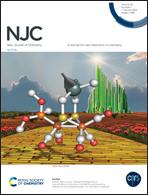Highly efficient and antibacterial ion exchanger based on graphene oxide for removal of chromate and nitrate from water: synthesis, characterization and application
Abstract
In this study, a new recyclable antibacterial anion exchanger based on graphene oxide (GO) and quaternary ammonium chloride (TMSQA) as a cross-linker/anion exchanger was synthesized and used for the separation of chromate and nitrate from water, which to the best of our knowledge has not been investigated before. The prepared anion exchanger was characterized by techniques such as FE-SEM, energy dispersive X-ray (EDX) analysis, FT-IR, TGA, XRD, and BET, and also its recyclability and antibacterial activity were investigated. The highest removal of NO3− and CrO42− in aqueous solutions containing 30 and 50 mg L−1 initial concentration of these ions, respectively, was 98% (29.3 mg g−1) and 100% (50 mg g−1) at pH 7 after 45 and 15 min contact time. The obtained experimental data were well fitted to the Langmuir isotherm and the pseudo-second-order rate kinetics. The exchanger (GO/TMSQA: 1/2) showed good antibacterial activity against Gram-positive B. subtilis and Gram-negative E. coli and showed no significant loss of exchangeability after four adsorption–desorption cycles. The removal of single valent nitrate was considerably inhibited in the presence of chromate, showing the superior binding of the bivalent chromate. The prepared anion exchanger has also shown suitable selectivity against sulfate and chloride ions as competing ions.



 Please wait while we load your content...
Please wait while we load your content...